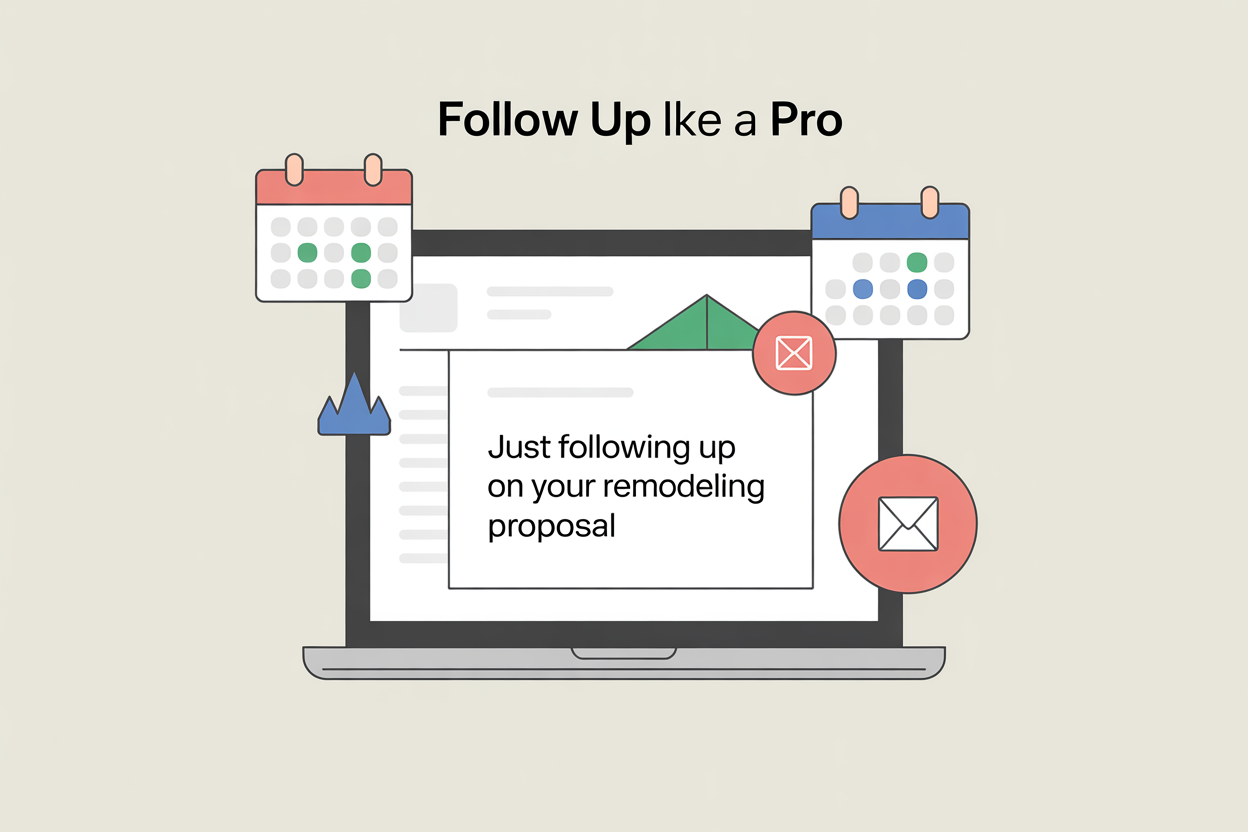If you’ve been a contractor for more than five minutes, you’ve probably heard this one before:
“Hey, we loved your bid… but another contractor came in a little lower.”
Cue the eye roll. Because you know exactly what that means…you just spent hours driving, measuring, estimating, writing, and emailing, only to lose the job to someone who’s charging less and probably cutting corners.
Here’s the truth most contractors don’t want to hear: price isn’t the real reason you’re losing bids. It’s an easy excuse clients use when they don’t have another clear reason to choose you. The real reason? Your presentation, speed, trust, and follow-up aren’t hitting the mark.
And the good news? That’s fixable, and the best part? You don’t have to lower your prices.
In this guide, we’re going to walk through 7 proven ways to win more remodeling jobs without competing on price.These are the same principles high-performing contractors use every day to close deals at healthy margins , even when their bids are 20% higher.
The Real Reason Clients Say “No” (Hint: It’s Rarely About Price)

Before we get into the strategies, let’s clear something up: homeowners aren’t sitting around with a spreadsheet comparing line items down to the penny. They’re trying to decide who they trust to tear apart and rebuild part of their home.
When they reject your bid, price is usually just the polite reason they give. The real reasons often look more like this:
- You took too long to respond. They already booked a walkthrough with someone else.
- Your proposal was confusing or unclear. They didn’t fully understand what they were getting.
- They didn’t feel confident in your business. Maybe there weren’t enough reviews, photos, or proof you could handle the job.
- You didn’t follow up. Out of sight, out of mind and the next contractor called back first.
If any of those sound familiar, you’re not alone. Most contractors lose work because of process, not price. And the best part? Process is something you can fix starting today.
Let’s walk through how.
1. Respond to Leads Fast…Because Speed Wins Home Remodeling Jobs

Here’s a hard truth that stings a little: homeowners hire the first contractor who makes their life easier. That usually means the first one who responds clearly, quickly, and professionally.
In fact, research shows that responding to a lead within the first minute can boost conversions by a staggering 391%. If you wait 24 hours, those chances take a nosedive.
Now think about how most contractors handle new leads. A homeowner fills out a form or leaves a voicemail. You’re on a jobsite swinging a hammer or threatening a subcontractor, so you call them back the next day. By then? They’ve already booked someone else for an estimate.
The fix is simple: set up a system that guarantees a fast, consistent response.
- Have a pre-written text or email ready to send within minutes.
- Use an office manager or virtual assistant to follow up on new leads in real time.
- Or better yet, automate it (more on that later).
For more on this, check out our guide on How To Answer The Phone When A Prospect Calls
Even if all you do is reply with:
“Hey [Name], thanks for reaching out about your project. I’d love to learn more, can you share a few details or a good time for a quick call?”
…it shows you’re on the ball. And that alone separates you from 80% of contractors.
2. Deliver Estimates in Hours, Not Days

Want to know how many jobs you’ve lost because someone else delivered their estimate first? Too many to count.
Clients don’t like waiting, especially homeowners eager to get a remodel started. If you’re taking 3–5 days to turn around an estimate, they’ve probably already signed with the contractor who got theirs over the same day.
Here’s the mindset shift: “good and fast” beats “perfect but late” every time.
I’m not saying you should slap together sloppy numbers. But you can absolutely deliver a preliminary estimate or a ballpark range within 24 hours, if not sooner, and that’s usually all the homeowner needs to keep you in the running. To avoid common pitfalls, read about the 5 Mistakes Contractors Make With Estimates.
With AI estimating tools like Handoff, you have no excuse not to provide a clear, professional, and accurate estimate in a few minutes or hours for bigger projects.
A few tips:
- Use templates for your most common project types so you’re not starting from scratch.
- Save material and labor costs in a database for quick reference.
- If possible, use tools that pull pricing automatically from suppliers and plug it into your estimates.
Even a message like:
“Based on what you shared, similar bathroom remodels I’ve done recently land between $18,000 and $24,000. I’ll follow up with a detailed estimate by Friday.”
…is better than silence. That single move keeps you top of mind and sets the tone that you’re responsive, organized, and serious.
3. Make Your Proposals Clear, Clean, and Easy to Say “Yes” To

Here’s a dirty secret about why many bids lose: the homeowner simply didn’t understand them.
Contractors live and breathe construction terms, but most clients don’t know their joists from their jambs. If your proposal looks like a spreadsheet written in Klingon, they’re going to feel confused. And confusion kills sales.
Instead, think of your proposal like a sales presentation. Your job isn’t just to give them numbers; it’s to make them confident in saying yes. Learn How to Win Contracting Bids Every Time with our in-depth guide.
Here’s what separates winning proposals from the ones that get ghosted:
- Clarity. Use plain language, short sentences, and clear headings. Instead of “Remove and replace existing subflooring per industry standards,” say “Tear out old subfloor and install new plywood base.”
- Scope breakdown. Separate labor, materials, and any optional upgrades.
- Visuals. Add photos, renderings, or diagrams if possible. People buy what they can see.
- What’s included / not included. This helps avoid misunderstandings later.
And here’s a pro move: include a short “Next Steps” section at the end of the proposal that spells out exactly how to move forward. For example:
“To book your project, just reply ‘Yes’ to this email or sign and return this proposal. Once we receive your deposit, we’ll schedule your start date.”
You’re not just giving them a quote, you’re guiding them toward a decision.
4. Position Yourself as a Specialist, Not a “We Do It All” Generalist

Most contractors make this mistake: they try to be everything to everyone. “We do kitchens, bathrooms, decks, roofs, drywall, painting…” and on and on.
You think that sounds versatile. Homeowners think it sounds unfocused.
People want the best person for their specific problem. If they’re doing a kitchen remodel, they’re not searching for “general contractor.” They’re searching for things like “kitchen remodel contractor” or “how much does it cost to remodel a bathroom in Orlando”
That’s why specialists win more jobs and, in turn, charge more for them. For more on this, check out our article on 10 Proven Contractor Marketing Strategies to Fill Your Pipeline.
If kitchens are your bread and butter, say so. Lead with it on your website, your Google profile, your social media. Show project photos that match that niche. Write content that educates people on kitchen design, layouts, and costs.
You can still take on other work, but from a marketing and positioning standpoint, niche down to stand out. You’ll go from sounding like “just another contractor” to sounding like the kitchen expert in town and that makes clients feel more confident signing with you, even if your price is higher.
5. Build Trust Before the Bid Ever Lands

Here’s something most contractors don’t realize: by the time a client reaches out, they’ve already done a ton of research. They’ve looked at your Google reviews, scrolled through your photos, and maybe even stalked your Instagram.
And they’re comparing that to everyone else they’re talking to.
This is where most bids are won or lost before the proposal even goes out.
If your online presence is thin, like a few blurry photos and a half-finished website, you’re starting at a disadvantage. On the other hand, if you’ve built a digital presence that screams credible, trustworthy, and experienced, you’re already halfway to the win.
Learn How to Ask for a Customer Review as a General Contractor to build your online reputation.
A few ways to build that trust:
- Google reviews. Aim for 20+ reviews with photos and detailed feedback. If you’re not asking happy clients for reviews, start.
- Before-and-after photos. Visual proof sells your skill far more than words.
- Mini case studies. Add short stories to your proposals: “Here’s how we helped a family update their 1970s kitchen into a modern open concept.”
- Certifications and licenses. Don’t assume clients know you’re licensed, let them know.
Think of your reputation like your armor. The stronger it is, the less price becomes part of the conversation.
6. Present Your Price With Confidence (Stop Apologizing)

If you flinch when you say your price, the client will too.
One of the biggest bid-killers is the contractor who’s defensive about their pricing. They start explaining themselves before the client even reacts. Or worse, they hint they might “sharpen their pencil” if needed.
You don’t need to apologize for your price. You need to justify it and anchor the value before you ever share the number. For tips on handling price objections, read our guide on 5 Common Price Objections General Contractors Face and How to Overcome Them.
Instead of leading with cost, lead with what they’re getting:
- “We only use premium materials with manufacturer warranties.”
- “We keep your home livable during construction, no dust storms in the kitchen.”
- “Our team is licensed, insured, and specializes in this exact type of project.”
Then, when you present the number, state it confidently and shut up.
Here’s a script that works wonders:
“We’re not the cheapest, and that’s intentional. Our clients hire us because they want the job done right the first time. Your investment for this project is $42,800.”
That line does two things: it reframes “expensive” as “premium” and reminds them that they’re investing in quality, not just buying labor.
7. Follow Up Like a Pro, Because Most Bids Are Won After You Send Them

Here’s a stat that’ll make you rethink how you handle bids: 80% of sales require five or more follow-ups after the initial proposal is sent, but 92% of sales reps give up after four attempts.
That’s like planting seeds and never watering them.
Homeowners are busy. They get distracted. They mean to reply but forget. Your follow-up is what nudges them back into the conversation and often, it’s what wins you the job. For a complete guide on social media marketing, check out The Ultimate Social Media Marketing Checklist for Remodelers & Home Builders.
Here’s a simple 3-step follow-up system you can implement right now:
- 24 hours after sending: A quick check-in: “Hey [Name], just checking in to make sure you received the proposal and see if you have any initial questions.”
- 3 days later: Add value: “Here’s a quick guide on how we manage dust and protect your home during a remodel.” (This builds trust and keeps you top of mind.)
- 7 days later: Final call: “We’re currently scheduling projects 4-6 weeks out. If you’d like us to reserve a spot, let me know by Friday.”
Most of your competitors stop after step one. This system keeps you in the running long after they’ve given up.
And yes, you can automate all of this. But even manual follow-ups will put you ahead of 90% of contractors overnight.
Bonus Tip To Win More Remodeling Jobs: The Secret Weapon Most Winning Contractors Use (and You Should Too)

Let’s be real: doing all of this manually is a lot. You’re already running job sites, managing crews, and trying to keep materials from doubling in price overnight. Adding “marketing system” and “proposal follow-up” to your list isn’t exactly fun.
That’s why more and more contractors are turning to AI-powered tools that take the admin off their plate, without hiring more people.Learn How to Win More Home Remodeling Jobs With AI and discover the 5 AI Tools You Can't Ignore in 2025.
These tools can:
- Instantly reply to new leads while you’re still on the jobsite
- Generate clean, professional estimates in minutes
- Format proposals that are easy to read and ready to sign
- Automate follow-ups so you don’t lose track of hot leads
It’s like having a front office team working for you 24/7, without paying a salary.
And once you experience how much time that saves (and how many more jobs you start winning), you’ll wonder how you ever ran your business without it.
Win Jobs Because You’re the Best…Not Because You’re the Cheapest
Here’s the bottom line: price isn’t the problem. It never was.
If you respond faster, deliver estimates quicker, present clearer proposals, position yourself as a specialist, build trust, present your price with confidence, and follow up like a pro, you’ll win more remodeling jobs even if you’re the most expensive bid on the table.
The contractors who dominate their markets aren’t the ones racing to the bottom. They’re the ones who build systems that make them look more professional, more reliable, and more valuable and they charge accordingly.
So the next time you hear, “We went with someone cheaper,” don’t take it personally. Take it as a sign to tighten your process.
Because once you do, you won’t have to compete on price ever again.















